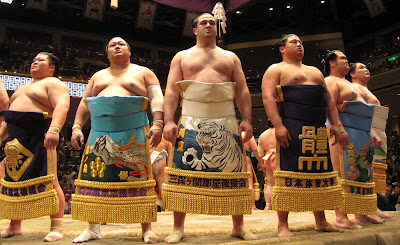
I went to a sumo (pronounced s'mo in Japanese) tournament yesterday, and I got a great seat! I paid for a cheap general admission ticket, but since it was a week day and I got there early I was able to sit in an unoccupied front row seat for most of the tournament.

I'm not big on sports, and I've never been to an American professional boxing or wrestling match, but I have to say that watching sumo was exciting, and not only because of the size of the wrestlers. Sumo originated more than 1500 years ago, as part of a harvest festival, but later became the national sport of Japan.

Today, the matches are decided really quickly, as soon as one of the wrestlers steps outside of the ring or touches the mat with any part of his body other than his feet. There are no weight limits in sumo, and the wrestlers are not matched for weight.

The day starts with the low-ranked or unranked wrestlers, but after lunch the higher ranked wrestlers come in during the entering the ring ceremony. They wear embroidered aprons that can cost $5,000 or even $10,000 each.

The higher-ranked matches last a little longer especially because of all of the maneuvering and stretching before each match.
 According to the brochure, this is the time when the wrestlers glare fiercely at each other, but compared to American wrestling that I've seen on TV I didn't think that their glare was that fierce in most cases.
According to the brochure, this is the time when the wrestlers glare fiercely at each other, but compared to American wrestling that I've seen on TV I didn't think that their glare was that fierce in most cases. 

Some of the sumo wrestlers, perhaps this one, have been recruited from other countries such as Bulgaria.
I was impressed that after each match the winner seemed to check to make sure that the loser was ok before returning to his side of the ring, and there was no taunting or cheering or shouting by the winner. The wrestlers just bowed to each other and left the ring.
The top wrestlers, or yokozuna, enter the ring wearing a massive braided hemp rope weighing up to 35 pounds tied in a bow at his back and ornamented in the front with zig-zag paper, a religious symbol in Japan.

Yokozuna are attended by other wrestlers, one bearing a sword, and they perform the dohyo-iri ceremony.

Before a match, each wrestler does a purification ceremony consisting of rinsing his mouth with water, wiping his body with a towel and throwing salt in the ring.

Sumo wrestlers wear a silk loincloth, approximately ten yards long and two feet wide. The loincloth is folded in six and then wrapped around the waist from four to seven times, depending on the girth of the wrestler. Many sumo moves involve grabbing an opponent's belt, but the wrestlers are not allowed to grab other parts of the loincloth. The high-ranked wrestlers wear a special topknot shaped like a gingko tree leaf.

Before and after the tournament, wrestlers wear kimonos and can be seen in the stadium and entering the building.

The referees, or gyoji, wear kimonos patterened after the samurai style from 800 years ago. Their black court hats are in the style of a traditional Shinto priest's hat. The lower-ranked gyoji are barefoot, but the higher ranked refs wear tabi socks.

Between matches, the water boy replenishes the salt basket, prepares the water and towels and helps sweep the ring.


At lunch time I tried a bowl of chanka nabe, the traditional food of sumo wrestlers.

The chanka tasted good and seemed pretty healthy, with lots of vegetables and just a bit of chicken. It doesn't seem like chanka would make you fat, but the key to sumo wrestlers' large physique is that they don't eat breakfast or lunch. They eat just one meal per day, dinner, and they go to bed immediately after eating. That way, the calories turn into fat while they sleep. Because they don't eat during the day they have a really low metabolism and don't process many calories during the day. Don't try this at home!
 Traditional Japanese seating at the sumo tournament
Traditional Japanese seating at the sumo tournament



1 comment:
K -
Fascinating post with some truly wonderful images. Thank you for sharing with us a glimpse of this unique world.
E
Post a Comment